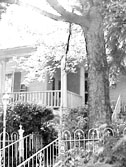|

1605 Brown Ave.
1,569 sq. ft.
2 bdrms, 1.5 bath
$84,200
Contact: Jennifer Montgomery
Coldwell Banker: 693-1111
Comment
on this story
|
 |

by Matt Edens
It was a secret place, overlooked and abandoned behind a locked gate and foreboding stone walls, a heap of weed-choked rubble forsaken by the lord of the manor. But for two young people—as forgotten and cast aside as the garden itself—it became a wonderful place where their imaginations ran wild and their dreams bloomed along with the flowers they lovingly freed from the ruins. And, as it turns out, making the garden whole again was the key to making their family whole again—able to appreciate not just the restored garden but themselves as well.
Odd that this classic children's tale of discovery and rebirth was written by someone who witnessed the blossoming of Knoxville firsthand well over a century ago. Frances Hodgson Burnett, like a lot of Knoxvillians I know, fell into this place almost by accident yet was, in many ways, never entirely able to let it go. The Secret Garden—her most revered work—was set in England but, as Metro Pulse's own Jack Neely outlined in a recent "Secret History" column, it owes a good deal to her Knoxville childhood.
It was a different Knoxville then that Fannie Hodgson grew up in. It was long before central Knoxville had been walled off by the interstates and locked up in a sprawl of suburbs. Some of what is weed-chocked and ruined now was shiny and new then. And none of it had been cast aside and forgotten for the simple reason that most of it hadn't even been built yet. Knoxville in the 1860s was raw and teeming, bursting forth like so much kudzu. The idea that it might someday be all but abandoned would have seemed far-fetched. I wonder if, when she sat down to pen it, Fannie had any idea how inspiring, and oddly applicable, her children's tale would be to the city that partly inspired it in the first place?
One thing I do know; if Frances Hodgson Burnett were alive and living in Knoxville today, she would live some place like this charming little Victorian cottage on Brown Avenue. Far from crumbling and not quite secret, it is certainly hidden away—a few blocks off Broadway and a stone's throw from more fashionable abodes like 4th and Gill and Old North Knoxville. And with a big double lot studded with dogwoods and magnolias and ancient wrought-iron fences, it's definitely a garden—a surprisingly secluded one at that (the 1st Creek Greenway is a short stroll down the hill as well).
The Secret Garden isn't the only one of Burnett's works this house evokes either. Currently the home of a friend with a distinctly artistic and literary bent, the house has hosted plenty of quasi-bohemian gatherings reminiscent of Burnett's first book, Vagabondia. Like The Secret Garden, the book owed a debt to her Knoxville youth—albeit a few years later when she and several artistically talented relations lived in a shabby-chic old mansion on the riverfront. And while this house is by no stretch a mansion, the rambling rooms, rich hardwood floors and 10-and-a-half-foot ceilings seem meant to echo with the chatter and laughter of a couple dozen friends drinking wine and talking about art, music and film. On a nice night you can open up the floor-to-ceiling Jefferson windows and let the party spill out onto the big front porch with its swing and cobwebby columns (of the classic Greek sort that Byron would have loved).
So go ahead. Buy this house. I doubt you'll regret the experience—whether or not you turn it into a novel.

July 10, 2003 * Vol. 13, No. 28
© 2003 Metro Pulse
|





